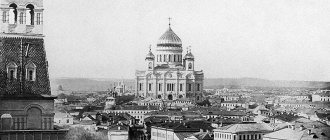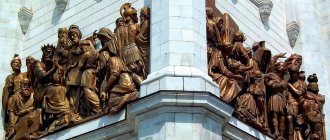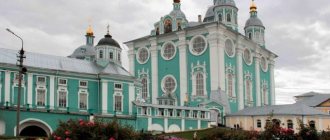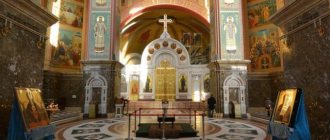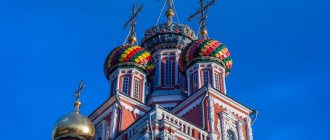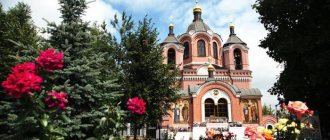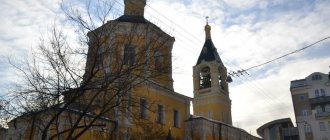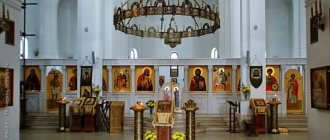The Cathedral of Christ the Savior is the cathedral of the Russian Orthodox Church, the largest Orthodox church in Russia, built on the banks of the Moscow River opposite the Kremlin. The church was built as a token of gratitude to the Lord for delivering Russia from the Napoleonic invasion. The fate of the temple, like a mirror, reflected the fate of Russia. For Moscow it means no less than the Kremlin and Red Square. Listed in the Guinness Book of Records as the world's largest Orthodox cathedral, it can accommodate 10 thousand parishioners.
The Martyr Church, mercilessly destroyed by the Bolsheviks during the Stalin era, has been restored according to the original design. The consecration of the memorial church on August 19, 2000, on the day of the Transfiguration of the Lord, became a symbol of the transformation of Moscow and Russia, the rejection of the atheistic past.
Time travel
Our ancestors built temples to the Savior and the Most Holy Theotokos in gratitude for the gracious help in life, for the miraculous salvation from death, for the granting of victories in battles with enemies.
Pages of history
During the Napoleonic invasion of 1812, 200 thousand Russian soldiers laid down their lives on the battlefields. After the end of the war, army general Mikhail Ardalionovich Kikin proposed to the emperor to perpetuate the victory of the Russian people, their courage and heroism.
On December 25, 1812, the tsar issued a manifesto ordering the construction of a church “in commemoration of gratitude to the Providence of God, which saved Russia from impending destruction,” in honor of Russia’s victory over Napoleon’s army. The temple being built, according to the emperor, should be distinguished by its grandeur and spiritual idea.
The Russified Swede, artist and architect Alexander Lavrentievich Vitberg, guessed the emperor’s desire, proposing to build a grandiose cathedral. Witberg's plan is impressive: 600 giant columns made from captured cannons, a 106-meter-long main staircase, a tomb for Russian soldiers with a building height of 170 meters and semicircular galleries, each of which is 640 meters long. The church was to be decorated with monuments to monarchs and prominent commanders, captured weapons obtained in battles with the French.
The project delighted the emperor: the site chosen for construction on the Sparrow Hills was located between the Smolensk road, along which the French entered Moscow, and the Kaluga road, along which the enemies fled from Moscow. 48 bells would signal the beginning and end of the service.
Attempt to build a temple
On the fifth anniversary of the expulsion of the French from Moscow on October 12, 1817, the foundation stone of the temple was solemnly laid. When designing, the young architect did not take into account the peculiarities of the soil, which collapsed and sank under the weight of the foundation.
Construction was delayed, groundwater and landslides disrupted the construction. In 1825, work was stopped. Vitberg’s project was considered unsuccessful and, accused of embezzlement of public funds, he was sent into exile in Vyatka.
The whole world
Emperor Nicholas I, who took the throne in 1832, entrusted the creation of a new project to the architect Konstantin Andreevich Ton with a proposal to build a church on a different site. They decided to build a new temple not far from the Kremlin on the banks of the Moscow River and for this purpose the Alekseevsky Convent was dismantled .
According to legend, the abbess of the doomed monastery refused to leave the monastery and chained herself to an oak tree. By special order of Nicholas I, the tree was dug up and, together with the abbess, moved to another place. Then she cursed the temple that would be on the site of the monastery, and predicted that it would only stand for 50 years.
On the day of the 25th anniversary of the Battle of Borodino, September 10, 1839, in the presence of the imperial family, a new temple was solemnly laid on the banks of the Moscow River. All of Russia collected money for construction, although a lot of funds came from the treasury. It took 44 years to build, and on May 26, 1883, in the presence of Alexander III and his family, it was consecrated, giving it the name of cathedral.
The word “cathedral” literally means “the place where the bishop sits.” For ease of administration, the territory of the Russian Orthodox Church is divided into regions (dioceses). Each diocese has a leader - bishop, archbishop, metropolitan - who serves in his cathedral. And the representative of the entire church - the Patriarch - serves in the main cathedral of the country.
New temple
The cathedral turned out great. Sculptures and paintings, icons and bas-reliefs, carvings and castings - what kind of talents people used to perpetuate the memory of their valiant ancestors and give praise to God! Vasily Surikov and Ivan Kramskoy, Vasily Vereshchagin and Henryk Semiradsky, Alexey Korzukhin and Fyodor Bruni worked on the painting of the temple, whose area is 22 thousand square meters (9 thousand gilded).
400 kg of gold were spent on gilding the domes . High relief statues of saints were made by sculptors Anton Ivanov, Nikolai Ramazanov, Alexander Loganovsky. Sculptor Peter Klodt is the author of the temple’s sculptural compositions.
The names of war heroes were inscribed in gold letters on marble plaques in the lower gallery. Composer Pyotr Ilyich Tchaikovsky wrote the patriotic overture “1812” for the consecration of the temple, timed to coincide with the coronation of the new Emperor Alexander III.
After the consecration, a state award was approved - the medal “In memory of the consecration of the Cathedral of Christ the Savior,” which was awarded to those who designed and built it.
The cathedral, the construction of which cost the treasury 15 million rubles, played a significant role in the socio-religious and cultural life of the capital of the Russian Empire. The new cathedral soon became a symbol of Moscow. The conductor of the choir of the Cathedral of Christ the Savior in 1918-1922 was A. V. Alexandrov, the author of the music for the anthem of the Soviet Union and the modern anthem of Russia.
Christmas tree
The New Year's performance is one of the most impressive in Russia. The performance is staged both based on famous fairy tales and specially written scripts. Actors from the best capital theaters are invited to play the roles. The scenery is created in advance for the performance. 3D effects are also used.
The peculiarity of the festive action is that the plot is connected with biblical stories. Children unobtrusively get acquainted with the basics of Orthodoxy and the holiday of the Nativity of Christ. For little guests, the holiday begins in the yard. They are greeted by fair buffoons and fairy-tale animals. The guys dance in circles, play, and then go to the hall.
It is important that children 6+ can attend performances on their own. They are helped to undress and escorted to the place indicated on the ticket. After the performance, the mummers hand the children over to their parents. The performances are new every time. During the entire period of the festive events, there were no repeats of the performances. One day, Patriarch Kirill watches the performance together with the little spectators.
Some tickets are distributed free of charge. They are given to children who find themselves in difficult life situations: disabled people, orphans, children from large poor families, children of fallen military and police officers. The rest of the spectators buy tickets.
Tragic times of the temple
The temple was built to last, but in all its splendor it stood for 48 years. The Bolsheviks who came to power demolished the main temple of Russia . By order of Stalin, it was blown up on December 5, 1931, and this was done only the third time. Two engineers, knowing that refusal would result in execution, did not agree to blow up the cathedral, on the site of which the authorities decided to build the Palace of the Soviets - a new symbol of the new era.
The tallest building in the world (4 times taller than the demolished temple) was supposed to represent the new country and victorious socialism. It was assumed that the giant ziggurat, 495 meters high (150 floors), would be crowned with a rotating 100-meter statue of the leader of the revolution, Lenin. The leader’s index finger will be 4 meters long, there will be a helipad on the palm, and in Lenin’s head, the height of a 5-story building, they decided to build a library.
The builders dug a huge pit and began to build the foundation. The plans did not come true: with the beginning of the Great Patriotic War, Moscow and all of Russia were under threat. Anti-tank hedgehogs were made from metal structures of Soviet new buildings for the defense of the capital. The walls of the metro were lined with marble slabs of the temple, and memorial plaques with the names of the heroes of the Fatherland were placed on the steps to the cloakroom of the Tretyakov Gallery. After the war, the Moscow outdoor swimming pool was built on the site of the temple.
Observation deck
The viewing platform is located at an altitude of 40 m. This is a great way to view Moscow from an unexpected point. Entrance here is paid, and you have to climb on foot. (Sometimes tourists manage to take the service elevator. How lucky.) But the efforts spent will be more than rewarded with an amazing panorama.
There are vending machines on the staircase landings. They sell coins with the image of the cathedral. Buying souvenirs will brighten up a boring climb. The site encircles the perimeter of the building. The area is protected from precipitation and bright sun. Moving around the site, you can view the capital from different angles. There are surveillance cameras everywhere, the railings are quite high, and there are additional fences. Therefore, looking around the city is not at all scary.
Photo and video shooting is allowed on the viewing platform. In some places, binoculars are installed for ease of observation. In order to use them, you will have to pay. Time spent on the observation deck is limited. It is half an hour.
It is important to remember: since the entrance to the site goes through the temple, you will have to comply with a certain dress code.
Second birth
For the first time, the first cosmonaut Yuri Alekseevich Gagarin proposed publicly restoring the Cathedral of Christ the Savior in the 60s, speaking at a meeting of the Central Committee plenum on the education of youth. The unprecedented courage caused confusion among the speechless communists: they tried to “hush up” the “inappropriate outburst”; words about the temple were cut out from Gagarin’s speech published in the media.
20 years passed, and at the end of the 1980s, the Holy Synod of the Russian Church turned to the Russian Government with a request to re-build the temple in the same place. Permission was received four and a half years later.
The pool was dismantled. And again the whole world collected money. With the support of the Moscow government, the cathedral was revived in 6 years . Thanks to the efforts and care of artists, sculptors, and restorers, it was resurrected from oblivion.
On the night of January 6-7, 2000, the Divine Liturgy was held in the revived church in honor of the two thousandth anniversary of the Nativity of Christ - the Coming into the world of our Lord and Savior Jesus Christ. On August 19, 2000, His Holiness Patriarch Alexy II consecrated the temple - a recreation of the 19th century temple of the same name, where the miraculous shrines were transferred.
, a cross made of clouds appeared and floated over the dome . The next day, the canonization of the executed Romanov family and the Council of New Martyrs and Confessors of Russia took place. Today, divine services are held here under the leadership of Patriarch Kirill of Moscow and All Rus', Bishops' Councils and international religious forums meet here.
Excursions
The shrine is of interest to tourists. You can visit the attraction with a group or alone. The following excursions are popular:
- sightseeing tour of the temple with a visit to the observation deck
- everything about the temple (acquaintance with the history of the building, study of treasures and Orthodox shrines)
- temple and panorama of the capital (with a visit to the viewing platform)
- a story about miracles that took place around an Orthodox shrine
An interesting comprehensive tour. It involves visiting all Orthodox churches in the center of Moscow.
Review of the new temple
The project of the new temple was developed by architects Mikhail Posokhin, Alexei Denisov and Zurab Tsereteli.
Cathedral architecture
The temple is designed in the form of an equilateral cross 85 meters wide, 103 meters high and divided into three parts:
- central part with an altar;
- upper galleries with two aisles;
- lower bypass gallery with a memorial in honor of the heroes of the military campaign of 1812-1814
The drum of the cathedral rises 28 m, the dome with the cross goes up 35 m. The height of the main cross is 8.5 m. The walls of the building are 3.2 m thick. The outer part of the cathedral is decorated with two rows of marble high reliefs. The main decoration is the golden domes with crosses crowning them.
The Cathedral of Christ the Savior is a complex of 3 buildings: the cathedral, the Church of the Transfiguration and a tent-roofed church-chapel in honor of the “Derzhavnaya” icon of the Mother of God, the main shrine of modern Russia. The church was built in memory of the Alekseevsky Convent. The main shrines of the Church of the Transfiguration are the icon of the “Savior Not Made by Hands” by the artist Sorokin, the ancient icon of the Mother of God “Smolensk” and the icon of St. Nicholas, formerly located in the church of the city of Bari.
The cathedral is the “upper temple”. The “Lower Church” refers to the Church of the Transfiguration, located below the “Upper Church”. Under the Cathedral of Christ the Savior there is a massive base, a ground floor 17 meters high. Here they built Refectory Chambers with 1,500 seats, where meals of Local and Bishops' Councils are held, premises for technical services, a museum and the Church of the Transfiguration, the Hall of Church Councils and the Hall of the Supreme Church Council.
The floor is decorated with marble and red granite. On each of the four sides the cathedral is surrounded by porches with a parapet of fine-grained dark red granite. There are large lanterns on the porches, and spacious platforms on the upper steps.
Exterior decoration
The outer walls are lined with marble and decorated with openwork arcades of semi-columns ending in pointed arches.
The southern facade from the side of the Moscow River is overshadowed by the Smolensk Icon of the Mother of God, the image of which remained in the Russian army for 3 months, and before the Battle of Borodino the shrine was carried among the ranks of the troops.
On the upper galleries there are chapels in the name of St. Nicholas the Wonderworker and St. Alexander Nevsky. On the eastern side of the temple there is a monument to Alexander II the Liberator. A little further from the temple there is a chapel in which they prayed for the revival of the temple.
The northern facade is dedicated to the foreign period of the Patriotic War. Here are the saints on whose memory days the Russian army won victories over Napoleon's army. In the central medallion is the Iveron Icon of the Mother of God. On the high reliefs are images of the apostles and saints who lived in the first centuries of the existence of the Church. The Monk Sergius of Radonezh blesses Prince Dmitry Donskoy for the Battle of Kulikovo and gives him two monks - Peresvet and Oslyabya.
On the eastern facade there is an image of the Nativity and Resurrection of the Savior. In the form of sculptural images - prayer books for Moscow and Russia: Saints Peter, Alexy, Jonah and Philip, Saint Sergius of Radonezh, Stephen of Perm.
Here is the Vladimir Icon of the Mother of God, placed here in memory of the Battle of Borodino, which happened on September 8 - the day of the feast of this icon. On the left corner of the temple - the Monk Dionysius, archimandrite of the Trinity-Sergius Lavra, blesses Prince Pozharsky and citizen Minin for the liberation of Moscow from the Poles.
There are 12 bronze gates leading to the temple, three on each side of the cathedral. On the gates are images of the holy heavenly intercessors of the Russian land. In the arch of the middle gate there is Christ the Savior on the throne, on the left is the Apostle Peter, on the right is the Apostle Paul.
Interior decoration
The interior of the temple was recreated by 300 artists from Moscow and St. Petersburg, Yaroslavl and Pskov, Novgorod and Podolsk, who passed a tough competitive selection. A group of masters worked under the guidance of academician and honored artist of the country N. A. Mukhin.
To paint the walls and vaults, a unique scaffolding system was installed. Paintings and gold leaf were used to decorate the interiors. The floor in the temple is made of precious marble, jasper and porphyry from Italy and France, Greece and Russia.
The gallery of military glory was returned to the temple . Along the perimeter of the walls there are 177 marble plaques describing the battles of the Russian army in the Patriotic War of 1812 and the foreign campaign of 1813-1815. Here is the emperor's manifesto and the names of the heroes of the Patriotic War, famous commanders and soldiers who distinguished themselves in battle. The high walls with vaulted ceilings are painted with the faces of saints. The decoration is dominated by red and gold colors.
In the central part there is an altar in the form of a tent - a symbol of the Cave of the Holy Sepulcher, where the Savior was buried. The tent, folded into an octagon, is an unconventional iconostasis: a chapel made of white marble, decorated with precious stones. The chapel is crowned with a tent-roofed dome with a cross.
On the lower tier of the iconostasis are icons of the Lord Pantocrator and the Blessed Virgin Mary. In the second tier on the right at the royal gate are icons of the Lord's feasts; on the left - the Mother of God. The icons of the third tier show the New Testament church with icons of Jesus Christ, the Virgin Mary and the apostles. In the fourth tier are icons of the forefathers and prophets of the Old Testament church.
In the altar is the throne of Patriarch Tikhon . In this temple in November 1917, Tikhon was elected patriarch. On both sides of the throne are 6 paintings by Vasily Petrovich Vereshchagin, miraculously preserved in 1931 during the explosion of the temple. The works illustrate the last hours of the Savior’s earthly life. Vasily Nesterenko’s composition “Entrance into Jerusalem” and “Baptism of the Lord” looks monumental.
On the arch of the main dome is the Lord of Hosts in the guise of an old man, on whose lap sits the Son of God with a charter in his hands, on which is written “logos” (from Greek “word”), on the old man’s chest is a dove, the image of the Holy Spirit. In the small domes are the Lord Pantocrator, Jesus Christ in the guise of the Child and the Savior Pantocrator and the Holy Spirit in the form of a dove.
In the sails (the base of the main dome) are episodes of the earthly life of Christ: Transfiguration, Resurrection, Ascension; on the fourth sail - the descent of the Holy Spirit on the apostles.
Bells and domes
The temple is crowned with 5 domes, the middle dome is larger than the others. The domes are cast from stainless steel coated with titanium. A thin layer of gold is applied to the surface using the ion-plasma method. Additionally, a layer of diamond dust protects the domes from destruction.
14 large and small bells on the four bell towers of the temple . The Large Solemn Bell, weighing 29.8 tons, sounds 4 times a year on great Orthodox holidays. Festive - on the days of the twelve holidays. The Polyeleos bell weighs 9.2 tons, the Budnichny one - 5.
Orthodox shrines
The Cathedral of Christ the Savior is the cathedral of the Russian Orthodox Church; it contains the most valuable shrines.
- Pieces of the Lord's robe.
- Particles of the Virgin's robe.
- Relics of Saint Philaret.
- A particle of the relics of the Apostle Andrew the First-Called.
- Head of Saint John Chrysostom.
- Particles of the relics of Saints Peter and Jonah.
- Relics of the Blessed Grand Duke Alexander Nevsky
- Relics of St. Basil the Great.
- Relics of Equal-to-the-Apostles Prince Vladimir.
- Relics of John the Baptist.
- Nail of the Holy Cross.
- Particles of the relics of St. Mary of Egypt.
- Head of St. Gregory the Theologian.
- Relics of St. Euphrosyne of Moscow.
- Relics of the Great Martyr Euphemia All-Praised.
- Relics of the Holy Great Martyr Theodore Stratilates.
- Relics of St. Michael Ialein.
- One of the Miracle-Working Copies of the Vladimir Icon of the Mother of God.
The relics that were temporarily brought to Moscow are displayed in the church. In the fall of 2011, the belt of the Mother of God was exhibited for the veneration of believers, in the winter of 2014 - the Holy Gifts of the Magi, in the summer of 2022 - the relics of St. Nicholas the Wonderworker, in October 2022 - the ark with the right hand of St. Spyridon of Trimyfutsky.
Architecture and interiors
Anyone who has seen the building will say that it is original. This is natural: architects did not just draw sketches and then prepare drawings. In their projects they embodied the ideas that they saw in the victory over Napoleon. A victory that was won not only by Russian weapons, but by the entire people.
The original temple
The creator of the original project, Witberg, was a Freemason. But the ideas of the mason brothers did not distort the image he created. Vitberg believed that the temple should be triune and consist of three connected and complementary parts:
- Underground, shaped like a coffin. This part is dedicated to the Nativity of Christ. Constant funeral services for fallen heroes were to be held here.
- Ground. This part is dedicated to the Transfiguration of the Lord and had a cruciform shape. This symbolically reflects the mixture of light and darkness in the human soul. This part was supposed to have a lot of statues.
- The top one, dedicated to the Nativity of Christ. It should have been round.
The temple was supposed to face the Moscow River. Thon's project also assumed a similar arrangement. But the scale was completely different. In those days, the tallest building was the bell tower of Ivan the Great. Contemporaries noted that the entire thing could have entered the cathedral under construction.
Ton managed to organically fit the temple into the ensemble of the Kremlin and Moscow churches. This became possible due to the favorable location of the building. The building was located at a distance from the Kremlin, but at the same time harmoniously combined with it.
The characteristic features of the temple of that period are:
- keel-shaped zakomari
- onion-shaped heads
- covered gallery running along the entire perimeter
These elements were borrowed from churches built by Russian architects in the 15th and 16th centuries. In the project, Ton moved away from the classics and gave preference to folk traditions. The architect managed to successfully combine elements of ancient Russian architecture and Byzantium. The author thereby showed the continuity of forms and at the same time new fashion trends.
- 30 best Moscow museums for children
- 30 best things to do in Moscow for kids
- 20 best parks in Moscow for families with children
Modern temple
The modern building was erected on a powerful stylobate. The construction of this part was required in order to restore the hill on which the original cathedral was located. The natural elevation was destroyed after an explosion in the 1930s.
Actually, the cathedral is a complex of several buildings that are connected by an architectural design:
- Church of the Transfiguration
- tent chapel of the icon of the Mother of God
- the temple itself
The Church of the Transfiguration of the Lord is located in the stylobate part. There are also office premises, a museum, refectories, halls of Councils and Cathedrals. A cathedral was erected above the stylobate. The chapel is a separate building. The building has 4 porches. To climb them, you will have to overcome 15 steps. The porches are lined with dark red granite. For lighting, lamps are installed on the upper platforms.
The interior is well illuminated by daylight. For this purpose, 60 windows are provided. The facade is decorated with kokoshnik arches. They are supported by 36 columns. The architectural lighting of the building deserves a separate description. Powerful lanterns send rays of soft, daylight-like light onto the façade. The domes are illuminated by lamps mounted on masts each 30 m long.
Museum of Church Art in the Temple
In the basement of the temple there is a museum of church art with two permanent compositions:
- History of the Cathedral of Christ the Savior.
- History of church art.
The first one contains fragments of memorial plaques from the destroyed temple, images of unrealized cathedral projects, the bell of the old temple, original icons and old photographs.
On the second there is a collection of icons of Crete, Greece and Byzantium. Russian icon painting, icons by royal painters from the Armory Chamber, and an unusual icon of the Mother of God of Palestine and Child are also presented here.
New life in the temple
The Cathedral of Christ the Savior is a cultural heritage site of the Russian Federation . In 2004, the Moscow government transferred the cathedral to the Russian Orthodox Church for indefinite and free use. The temple is managed by the Christ the Savior Foundation: it attracts philanthropists, manages donations, rents out temple halls, conducts exhibitions and excursions, and cooperates with the Board of Trustees of the temple.
Tourists visit the museum and the Cathedral Halls, where they get acquainted with the history of the country and are convinced of the talents and courage of the people. From the observation decks located on the fourth floor, the capital's quarters and the Kremlin are clearly visible. Excursions are also available for children. Filming and photography in the temple is prohibited. Admission is free - passage through security and metal detectors.
The temple complex is equipped with a modern ventilation and air conditioning system, heating and elevator equipment, communications and an alarm, broadcast and control system.
On February 21, 2012, drama broke out in the temple - the Pussy Riot group staged an opposition rally and performed a punk prayer in protest against Vladimir Putin before the elections. For insulting the feelings of religious girls, they were imprisoned for a year and a half, but on the eve of the Olympics in Sochiv in 2014 they were released. Controversies in the press made the group members world famous.
The church hosted the funeral service of His Holiness Patriarch Alexy II, farewell to Georgy Sviridov and Boris Yeltsin, Mstislav Rostropovich and Igor Moiseev, Lyudmila Zykina and Sergei Mikhalkov, Vyacheslav Tikhonov, Galina Vishnevskaya, Elena Obraztsova, Valentin Rasputin, Andrei Karlov.
The twice-born temple lives a new life, reflected by the golden domes in the Moscow River. And every day they pray for the preservation of our Fatherland.
Bells
Of course, it would be better to return the original bells to the temple. But of all those in the belfry, only one has survived. And it is located in the Trinity-Sergius Lavra. All that remains of the rest are vague images and approximate descriptions in local history literature. Therefore, a competition was announced to create bells. Foundries from Russia and abroad took part in it.
The conditions were quite strict. It was necessary to present the manufactured bells to the commission in a short time. The weight must be from 8 kg to 3.5 tons. The number of copies is 10 or more. And what’s important: you had to work with your own material and at your own expense. 13 enterprises presented their options. But only 2 companies reached the finals: ZIL and LITEX.
Unfortunately, the commission was unable to draw a clear conclusion. Therefore, the competition was extended, and historians and acousticians were involved in the work. Only for the second time the expanded commission was able to determine the winner. It turned out to be ZIL. The trial bell took pride of place in the museum. In order to fulfill the order, the prototype was tested and the sound error was eliminated.
In 10 months, ZIL produced:
- Large bell (its mass is about 30 tons)
- Festive
- Polyeleum (weighing a little more than 9 tons)
Everyday (weighing 5 tons)
Such a deadline for completing a complex order is a record. Contractors from Italy stated that it would take at least 3 years to produce the bells.
